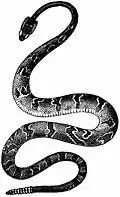虫
| ||||||||
| ||||||||
Translingual
| Stroke order | |||
|---|---|---|---|
 | |||
Han character
虫 (Kangxi radical 142, 虫+0, 6 strokes, cangjie input 中一戈 (LMI), four-corner 50136, composition ⿱中⿰㇀丶)
- Kangxi radical #142, ⾍.
Derived characters
- Appendix:Chinese radical/虫
- 𭂌, 𠙍, 𫩮, 𡘗, 独, 𢘷, 𢫼, 浊, 𨹁, 𨒷, 𣆣, 𣑺, 𣭦, 烛, 𤙕, 𦚭, 𭺟, 䂈, 𪿛, 𧙽, 𬗌, 触, 𧳃, 赨, 𫏪, 鉵, 𮨩, 𮩿, 䶚
- 𠛿, 㰩, 䳋, 𭜫, 茧, 𤼭, 萤, 𬝋, 𦳶, 𫢀, 𦸞, 𩭃, 𠣜, 𭕛, 痋, 閩(闽), 繭, 虄
References
- KangXi: page 1076, character 19
- Dai Kanwa Jiten: character 32804
- Dae Jaweon: page 1545, character 7
- Hanyu Da Zidian (first edition): volume 4, page 2833, character 1
- Unihan data for U+866B
Chinese
Glyph origin

| Historical forms of the character 虫 | ||
|---|---|---|
| Shang | Western Zhou | Shuowen Jiezi (compiled in Han) |
| Oracle bone script | Bronze inscriptions | Small seal script |
 |  |  |
| Old Chinese | |
|---|---|
| 虺 | *hŋuːl, *hŋruːl, *hŋlulʔ |
| 豗 | *hŋuːl |
| 鼿 | *hŋuːl, *ŋuːd |
| 虫 | *hŋlulʔ |
| 髡 | *ŋ̊ʰuːn |
| 軏 | *ŋod, *ŋuːd |
| 扤 | *ŋod, *ŋuːd |
| 兀 | *ŋuːd |
| 杌 | *ŋuːd |
| 屼 | *ŋuːd |
| 矹 | *ŋluːd |
Pictogram (象形) : a snake.
The character originally represented a type of venomous snake, while the derivative 蟲 represented worms and insects (or insect-like things). 虫 was later borrowed for 蟲 (possibly via simplification), and the character 虺 was created to represent the original meaning.
Etymology 1
| For pronunciation and definitions of 虫 – see 蟲 (“insect; bug; creature, animal; etc.”). (This character, 虫, is the simplified and variant form of 蟲.) |
Notes:
|
Etymology 2
| For pronunciation and definitions of 虫 – see 虺 (“venomous snake; snake; etc.”). (This character, 虫, is an ancient form of 虺.) |
Japanese
Shinjitai | 虫 |
Kyūjitai | 蟲 |
Kanji
(grade 1 “Kyōiku” kanji, shinjitai kanji, kyūjitai form 蟲)
- insect, bug
- generic name for animals
Readings
As shinjitai form of 蟲:
- Go-on: じゅう (jū)←ぢゆう (dyū, historical)
- Kan-on: ちゅう (chū, Jōyō)←ちゆう (tyū, historical)
- Kun: むし (mushi, 虫, Jōyō)
As the ancient form of 虺:
- Go-on: け (ke)←け (ke, historical)←くゑ (kwe, ancient)
- Kan-on: き (ki)←き (ki, historical)←くゐ (kwi, ancient)
- Kun: まむし (mamushi, 虫)
Compounds
- 虫媒 (chūbai)
- 益虫 (ekichū, “beneficial insect”)
- 回虫, 蛔虫 (kaichū)
- 害虫 (gaichū, “harmful insect”)
- 寄生虫 (kiseichū, “parasite”)
- 駆虫 (kuchū)
- 甲虫 (kōchū, “beetle”)
- 昆虫 (konchū, “insect”)
- 成虫 (seichū)
- 精虫 (seichū)
- 蠕虫 (zenchū, “worm”)
- 爬虫 (hachū), 爬虫類 (hachūrui)
- 防虫 (bōchū)
- 幼虫 (yōchū, “larva”)
Etymology
| Kanji in this term |
|---|
| 虫 |
| むし Grade: 1 |
| kun’yomi |
| Alternative spelling |
|---|
| 蟲 (kyūjitai) |
/musi/ → /muɕi/
(This etymology is missing or incomplete. Please add to it, or discuss it at the Etymology scriptorium.)
Pronunciation
- Kun’yomi
- (Tokyo) むし [mùshí] (Heiban – [0])[1][2]
- IPA(key): [mɯ̟ᵝɕi]
Noun
虫 • (mushi) (kyūjitai 蟲)
- a bug, insect, worm
- Synonym: 昆虫 (konchū)
- a serpent, snake
- 獅子身中の虫
- shishi shinchū no mushi
- a serpent in a lion
- Synonym: 蛇 (hebi)
- 獅子身中の虫
- (figurative): a worm (person living for only one thing)
- 本の虫
- hon no mushi
- a bookworm
- 本の虫
- (derogatory): a worm (despicable person)
- 泣き虫
- nakimushi
- a sobbing worm; a blubberer
- 泣き虫
- a temperament (thought which is in the deep in mind) (Can we verify(+) this sense?)
- 癇の虫
- kan no mushi
- a choleric temperament
- 癇の虫
- (archaic) a male lover
- Synonyms: 愛人 (aijin), 情夫 (jōfu), 隠し男 (kakushi-otoko)
Derived terms
- 虫食い (mushikui, “worm-eaten”)
- 虫酸, 虫唾 (mushizu, “heartburn”)
- 虫歯 (mushiba, “bad tooth, dental caries, cavity”)
- 虫偏 (mushihen)
- 虫眼鏡 (mushi megane, “magnifying glass”)
- 青虫 (aomushi)
- 油虫 (aburamushi, “cockroach”)
- 毛虫 (kemushi, “caterpillar”)
- 座頭虫 (zatōmushi, “harvestman”)
- 鈴虫 (suzumushi)
- 長虫 (nagamushi)
- 泣き虫 (nakimushi, “crybaby”)
- 鋏虫, 蠼螋 (hasamimushi, “earwig, maritime earwig”)
- 水虫 (mizumushi)
- 松虫 (matsumushi)
- 蝮 (mamushi, “viper”)
- 弱虫 (yowamushi, “weakling”)
References
- 2006, 大辞林 (Daijirin), Third Edition (in Japanese), Tōkyō: Sanseidō, →ISBN
- 1998, NHK日本語発音アクセント辞典 (NHK Japanese Pronunciation Accent Dictionary) (in Japanese), Tōkyō: NHK, →ISBN
Korean
Etymology 1
From Middle Chinese 蟲 (MC ɖɨuŋ).
Hanja
Wikisource虫 (eumhun 벌레 충 (beolle chung))
- Alternative form of 蟲 (蟲, “Hanja form? of 충 (“insect; bug”).”)
Etymology 2
From Middle Chinese 虫 (MC hʉiX).
Hanja
虫 (eumhun 벌레 훼 (beolle hwe))
- Alternative form of 虺 (虺, “Hanja form? of 훼 (“type of poisonous snake”).”)
References
- 국제퇴계학회 대구경북지부 (國際退溪學會 大邱慶北支部) (2007). Digital Hanja Dictionary, 전자사전/電子字典.
Vietnamese
Han character
虫: Hán Việt readings: trùng (
虫: Nôm readings: tròng[1][2], trùng[1][2], chòng[1], chùng[3]
- chữ Hán form of trùng (“Kangxi radical 142”).
References
- Nguyễn (2014).
- Nguyễn et al. (2009).
- Trần (2004).
- Bonet (1899).
- Génibrel (1898).